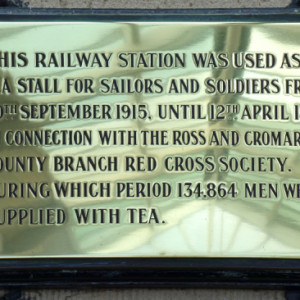Echoes of the Great War
This large wooden cross, fashioned from a shell-shattered tree, stands outside Dingwall railway station in the Highlands. It was originally erected in November 1917, in the village of Fontaine Notre Dame in France, in honour of the Seaforth Highlanders who had fallen at the Battle of Cambrai. With the efforts of Colonel T.W. Cuthbert, C.M.G., D.S.O. it was brought home to Dingwall in 1924.The rustic cross stands on a plinth of granite from the Ardross Estate. The panels on the plinth have the names of the five officers and thirty-five soldiers who fell on the 21st and 22nd November 1917. The inscription on one panel reads "This cross was brought home from France in 1924 and re-erected by the 4th Seaforth Reunion Club 1914-1918. In memory of their beloved dead. No burdens yonder, all sorrows past, no burdens yonder, home at last."
The first "extra" shows a train coming from the North into Dingwall station. During the Great War a troop train, which became known as the Jellicoe Express, passed along this line on a daily basis. In 1917 a route had been introduced to run a daily service direct from London Euston to Thurso, the nearest station to Scapa Flow in Orkney where the Grand Fleet was based. At just over 700 miles, it was Britain's longest rail journey and is calculated to have transported almost 500,000 military personnel, as well as the fleet's mail, between 15 February 1917 and 30 April 1919. Up to 500 personnel could be packed into each train and the journey took about 22 hours. Refreshment stops were provided at intervening stations and Dingwall Station has a brass plaque, "extra 2", commemorating the 134,864 cups of tea served during the entire War by Red Cross volunteers.



Comments
Sign in or get an account to comment.


